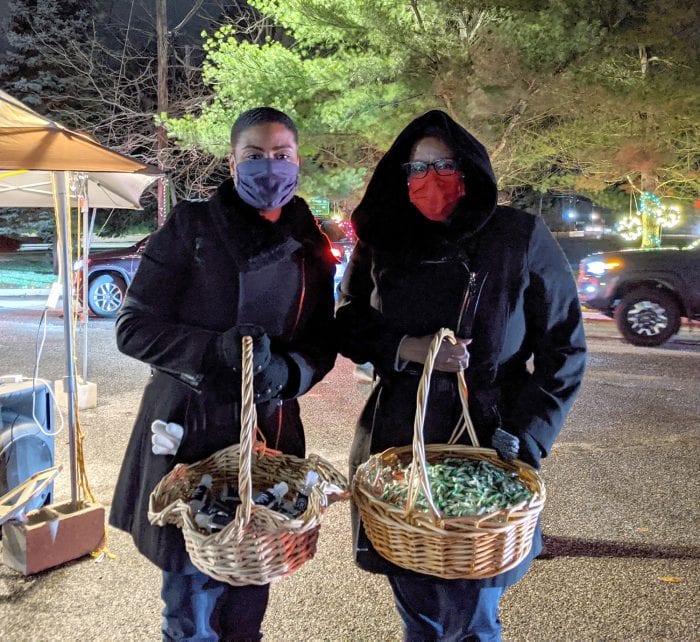Town of Brookhaven Councilwoman Valerie Cartright (D-Port Jefferson Station) could be seen as the maverick of the Town Board. Of the five other councilmembers and the supervisor, she is the only Democrat. Beyond that, she was the first Black person elected to the board in the town’s history.
And by next year, Cartright will move on to the New York State Supreme Court. In a Zoom interview with TBR News Media, the councilwoman said that while she will try to remain involved in the community, it will no longer be in an official capacity.
“It has really given me a different perspective on what governance of a municipality truly means.”
— Valerie Cartright
Cartright said she was tapped to run for Supreme Court justice this year after the results of the state Senate District 1 primary. After she was asked, she took some time to think about the move.
“It was clear to me that, you know, based on all of my experience as an attorney — I’ve been a civil rights attorney for 17 years or so now — and I’ve been fighting for fairness and equity within our judicial system during that time,” she said. “Those have always been paramount concerns for me. So it was a natural progression to some degree.”
Based on all counted ballots, Cartright received the most votes of all Suffolk supreme court candidates, though voters did have little choice to which justices were on the ballot due to cross party endorsements. Justices serve for 14-year terms, and though she still intends to live in Port Jefferson Station, by the nature of her office, she will have little to no involvement in politics. Instead, she said her focus on the bench will be toward justice within the legal system.
“When you’re in court, it’s the last-mile marker of the justice system — you’ve tried everything else,” she said. “I’ve found some of the judges that I’ve sat before or have come before that they were not listening to both sides of the argument — they were not giving people their day in court as I would have liked.”
It’s been an interesting seven years on the Town Board, ones which included initiatives to revitalize Port Jefferson Station and combat homelessness in the area, environmental issues and water-quality issues with local bays and harbors, and the ever-present contest between developers and those looking to preserve land. And then 2020 came along with all the issues caused by the COVID-19 pandemic and the spark of protests that ran all across the country plus the backlash to those protests. Council District 1 has been home to a multitude of rallies and protests from both sides.
Cartright said the key has been to listen and become intimate with the various local groups in her area. CD 1 is home to a diverse population in areas like Port Jefferson Station and Terryville, as well as the more opulent areas on the North Shore. It maintains several unique historic areas in Setauket and Stony Brook, various civic groups and chambers of commerce. It also contains four independent incorporated villages, all with their own small forms of government.

The varying levels of municipal and civic groups make it a challenge for anybody looking to get their feet wet in governing, but Cartright called it “a pleasure” getting to know all the different organizations and governing bodies. Being able to see things from both a macro and micro level, one thing she looked toward was taking small ideas and introducing them to the town on a wider basis.
“It has really given me a different perspective on what governance of a municipality truly means,” she said.
As the lone Democrat on the board, Cartright has had no other option than work with her Republican counterparts. While she said that the board has frequently worked together despite politics, Cartright has often enough been a lone voice of dissent on several issues. Just recently, at a December Town Board meeting, she and Supervisor Ed Romaine (R) went back and forth over plans to add parking meters at several town parks and beaches. The board passed that impending change, where Cartright also voted “yes.”
The upcoming Supreme Court justice said it has long been an effort to increase transparency. Such efforts include a community connection campaign, where she pulls information relevant to the district and sends it in an email blast to community members. She also lauded her roundtable discussions she’s had with civic and chamber leaders, as well as the town planning and law departments, as well as her own office to discuss pending applications for new development.
“I know there are times when I don’t vote the way that some of my community wants me to vote, but all of those votes, all those decisions that I make, are informed decisions,” she said. “And they’re done based on all of the community input that I can receive.”
It is something she hopes the next person to represent CD1 will continue. She said the three biggest issues coming up for whomever takes over the seat are going to maintain diversity representation so that “the board has a diverse body representing the community itself, the town itself.”
The second big issue would be the landfill, which the town plans to close by 2024. Capping the landfill will represent a big blow to town finances and will likely mean a new kind of waste crisis for the entirety of Long Island. The other aspect to that is the environmental impact, as the town is now considering putting in a new ashfill site at the landfill, which some groups have opposed. Whoever takes over her seat, she said, will need to consider all sides and help build consensus.
“We need to push outside of what is customary, so that we can actually help those that are being impacted by these things like food insecurity and homelessness.”
— Valerie Cartright
The third issue, she said, is going to be quality of life. Especially because of the pandemic, more and more people are experiencing food insecurity. Lines at food pantries and soup kitchens are increasing, which are only exacerbated by an ongoing homelessness crisis in the area.
“I think that we need to do more and we need to be creative,” she said. “And we need to push outside of what is customary, so that we can actually help those that are being impacted by these things like food insecurity and homelessness.”
What happens now, she said, is a transition phase for her office. She is developing a comprehensive list of what’s going on with her staff, while bringing in all the local civic, chamber and governing groups to compile that info on all large projects.
“What is going to happen is when the new elected official steps into office, there’s going to be community organizations and individuals that are already going to be armed with what needs to move forward — so the community will be able to hold [the new councilperson] accountable as to some of these initiatives,” she said.







